
Gustavo A. Madero is the northernmost borough of Mexico City.
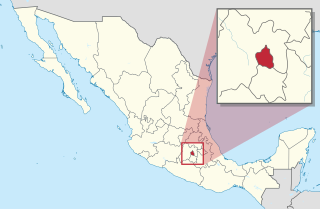
Mexico City is one of the 32 federal entities of Mexico, the others being the 31 states. It was named Distrito Federal up to February 5, 2016, when it was officially renamed the Ciudad de México. According to the 2020 Mexican Census, it is the second most populated entity with 9,209,944 inhabitants and the smallest by land area spanning 1,494.3 square kilometres (577.0 sq mi).

Aragón metro station is a Mexico City Metro station within the limits of Gustavo A. Madero and Venustiano Carranza, in Mexico City. It is an at-grade station with one island platform, served by Line 5, between Eduardo Molina and Oceanía stations. Aragón station serves the colonias of Casas Alemán and Simón Bolívar. The station is named after the San Juan de Aragón Park, and its pictogram represents the silhouette of a squirrel. Aragón metro station was opened on 19 December 1981, on the first day of the Consulado–Pantitlán service. In 2019, the station had an average daily ridership of 7,547 passengers, making it the 172nd busiest station in the network and the eighth busiest of the line.

Indios Verdes metro station is a station of the Mexico City Metro along Insurgentes Norte Avenue in the colonias (neighborhoods) of Residencial Zacatenco and Santa Isabel Tola, in Gustavo A. Madero, Mexico City. It is an at-grade station with two island platforms that serves as the northern terminus of Line 3. It is followed by Deportivo 18 de Marzo station. The station and its surrounding area are named this way because of the verdigris statues of Itzcoatl and Ahuitzotl, both Aztec rulers. They are located in Mestizaje Park and are collectively known as the Monumento a los Indios Verdes; the statues are featured in the pictogram. The station was opened on 1 December 1979, on the first day of service between Indios Verdes and Hospital General stations.

Autobuses del Norte metro station is a Mexico City Metro station in Gustavo A. Madero, Mexico City. It is an at-grade station with two side platforms, served by Line 5, between Instituto del Petróleo and La Raza stations. Autobuses del Norte station serves the colonias (neighborhoods) of Ampliación Panamericana and Capultitlan. The station's pictogram features the front of an intercity bus, and its name is on account of its proximity to Mexico City's Northern Bus Terminal. Autobuses del Norte metro station was opened on 30 August 1982, on the first day of the Politécnico–Pantitlán service. The station is partially accessible. In 2019, the station had an average daily ridership of 22,685 passengers, making it the 68th busiest station in the network and the third busiest of the line.
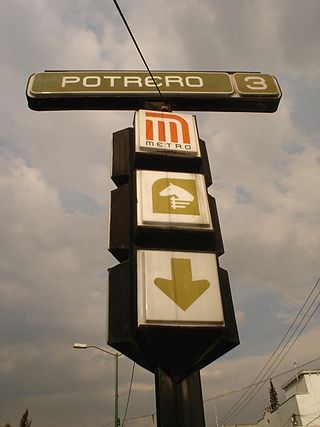
Potrero metro station is a station of the Mexico City Metro built along Insurgentes Norte Avenue in the colonias (neighborhoods) of Capultitlan and Guadalupe Insurgentes, in Gustavo A. Madero, Mexico City. It is an at-grade station with one island platform served by Line 3 between Deportivo 18 de Marzo and La Raza stations. The station and its surrounding area are named this way because there used to be a hippodrome during the Porfiriato era (1876–1911) and its pictogram features the silhouette of a head of a horse behind a fence. The station was opened on 1 December 1979, on the first day of service between Indios Verdes and Hospital General metro stations.

Colonia Villa de Guadalupe is a former separate town, now a neighborhood in northern Mexico City which in 1531 was the site of the apparition of Our Lady of Guadalupe, the most renowned Marian apparition in the Americas. She is venerated in the Our Lady of Guadalupe Shrine, located in the villa (town).

Ciudad Nicolás Romero is the largest city and municipal seat of the municipality of Nicolás Romero in State of Mexico, Mexico. It is located 58 km from the city of Toluca, the state capital and lies in the north-central part of the state, just northwest of the Federal District. The seat/municipality's current name is to honor Nicolás Romero, who fought for Benito Juárez during the Reform War and the French intervention in Mexico. He was executed there by the French. The town adopted this name in 1898. The area was settled by the Otomi and named Azcapotzaltongo by the Aztecs after conquering it. During colonial times, it was known as San Pedro Azcapotzaltongo. It was then called Monte Bajo from 1821 to 1898, when the current name was adopted. Both the municipality and city are commonly referred to as Nicolás Romero.
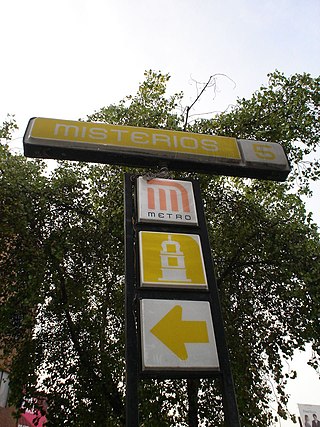
Misterios metro station is a Mexico City Metro station within the limits of Cuauhtémoc and Gustavo A. Madero, in Mexico City. It is an underground station with two side platforms, served by Line 5, between La Raza and Valle Gómez stations. Misterios station serves the colonias (neighborhoods) of Peralvillo and Vallejo.
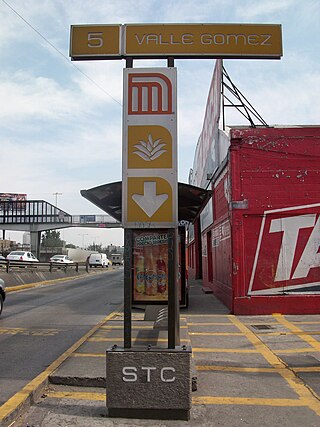
Valle Gómez metro station is a Mexico City Metro station within the limits of Gustavo A. Madero and Venustiano Carranza, in Mexico City. It is an underground station with two side platforms, served by Line 5, between Misterios and Consulado stations. Valle Gómez station serves the colonias of 7 de Noviembre and Valle Gómez; the station receives its name from the latter. The station's pictogram features an agave plant. Valle Gómez metro station was opened on 1 July 1982, on the first day of the La Raza–Pantitlán service. In 2019, the station had an average daily ridership of 4,416 passengers, making it the 190th busiest station in the network and the least busy of the line.
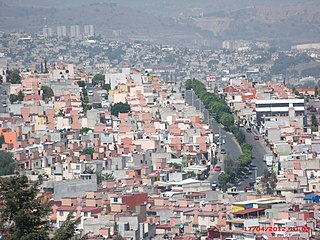
Tultitlán de Mariano Escobedo is the fourth largest town in and municipal seat of the municipality of Tultitlán located in the northeastern part of the State of México in Mexico. It lies adjacent to the northern tip of the Federal District and is part of the Greater Mexico City urban area. Both the city and the municipality are interchangeably known as San Antonio Tultitlán or simply Tultitlán, a name which comes from Náhuatl meaning "among the tule plants". "de Mariano Escobedo" was added to the city's name in 1902 in honor of the general who fought in the Mexican–American War and for the liberals during the period of La Reforma with Benito Juárez.
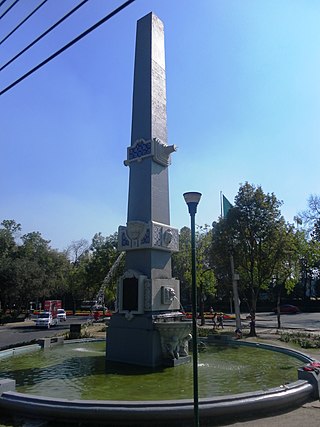
Polanco is a neighborhood in the Miguel Hidalgo borough of Mexico City. Polanco is an affluent colonia, noted for its luxury shopping along Presidente Masaryk Avenue, the most expensive street in Mexico, as well as for the numerous prominent cultural institutions located within the neighborhood.

Lindavista is a neighbourhood in the north of Mexico City, in the administrative district of Gustavo A. Madero. The streets in Lindavista are named after cities in Latin America.

Ecatepec, officially Ecatepec de Morelos, is a municipality in the central Mexican state of Mexico, and is situated in the north part of the greater Mexico City urban area. The municipal seat is San Cristóbal Ecatepec.

San Miguel Chapultepec is a colonia or neighborhood in Delegación Miguel Hidalgo in Mexico City.
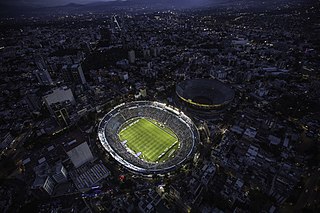
Ciudad de los Deportes is a neighborhood in Benito Juárez, Mexico City.

San Pedro de los Pinos is a neighborhood located in center-west of Mexico City. Before being urbanized during the first half of the 20th century, the colonia was part of a vast farming area belonging to several ranches and haciendas.

Colonia Verónica Anzures is a colonia of Mexico City located in the Miguel Hidalgo borough. The neighborhood is a residential area but it also houses some office buildings, most importantly the Torre Ejecutiva Pemex.
Verónica Castro is a small neighborhood (colonia) of Mexico City in the Gustavo A. Madero borough.



















